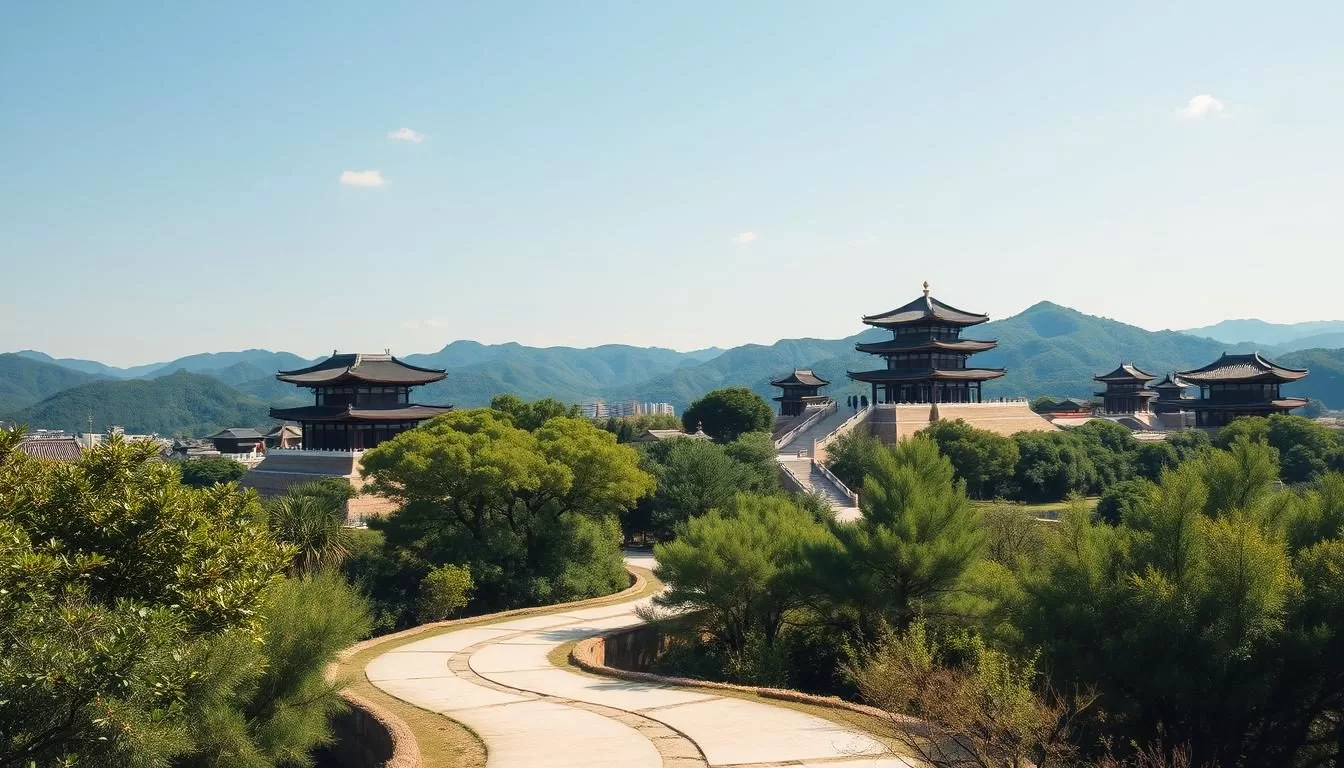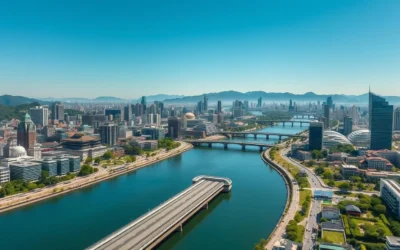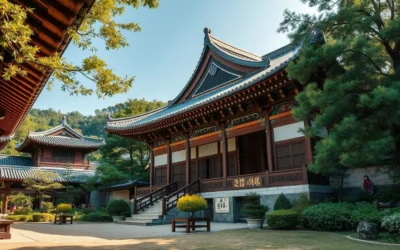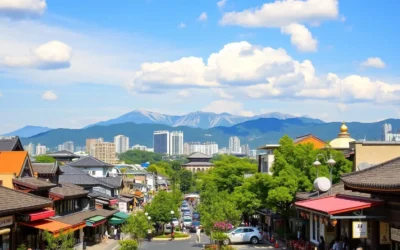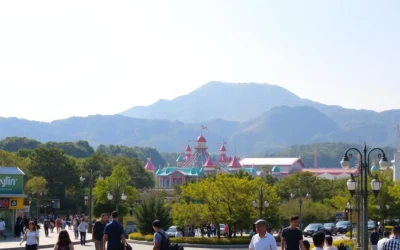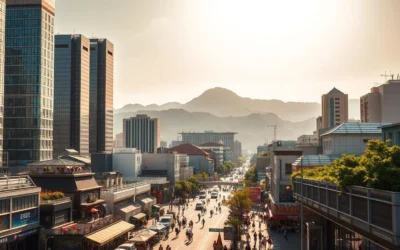✓ Accommodations✓ Flights✓ Rental Cars✓ Tours & Activities
Welcome to a city where history and modernity blend seamlessly. This guide is your key to unlocking the treasures of a destination that’s both timeless and vibrant. Whether you’re a history buff, a culture enthusiast, or simply looking for a unique travel experience, this city has something for everyone.
From ancient tombs to bustling streets, this city offers a mix of the old and the new. It’s a place where you can walk through centuries of history and still enjoy the comforts of modern life. The Gyeongju Historic Area, spanning approximately 2 km, is perfect for a leisurely stroll.
Prepare to explore hidden corners and discover insider tips that will make your visit unforgettable. This guide covers everything from transportation to food spots, ensuring you have all the details you need. Get ready to create an itinerary that lets you experience the best this city has to offer.
Discover the Rich History of Gyeongju
Step into a city where every corner tells a story of a bygone era. This destination is a treasure trove of history, offering a glimpse into the legacy of the Silla Dynasty, which ruled for nearly a thousand years. From ancient tombs to well-preserved temples, the city is a living museum that connects the past to the present.
Uncover the Silla Dynasty Legacy
The Silla Dynasty left an indelible mark on this city, shaping its culture, architecture, and traditions. As the capital of the kingdom from 57 BCE to 935 CE, it was the heart of a civilization that thrived for centuries. Today, you can explore over 150 royal tombs, each a testament to the grandeur of this ancient era.
Walking through the city, you’ll encounter centuries-old sites that have stood the test of time. These monuments are not just relics of the past but are seamlessly integrated into the modern landscape. It’s a unique experience where history feels alive and accessible.
Why Gyeongju Is Known as the “Museum Without Walls”
This city is often referred to as a museum without walls because of its vast collection of historical relics scattered across its streets. Unlike traditional museums, here, every step you take brings you face-to-face with century-old artifacts and structures.
From the Cheomseongdae Observatory, the oldest astronomical observatory in Asia, to the Bulguksa Temple, a UNESCO World Heritage site, the city’s landmarks are a testament to its rich heritage. The Gyeongju National Museum further complements this experience, showcasing artifacts that tell the story of the Silla Dynasty in vivid detail.
Immerse yourself in this narrative of the past as you explore the city’s key sites. Whether it’s the ancient tombs or the well-preserved temples, each location offers a unique window into a century of history that continues to inspire and captivate visitors.
Explore Ancient Tomb Complexes and Tumuli Park
Step back in time as you wander through ancient burial grounds that whisper stories of a forgotten era. The Daereungwon Tomb Complex is a sprawling site featuring 23 small and large ancient tombs, each a testament to the grandeur of the past. These grassy mounds, some reaching up to 30 meters in height, are more than just burial sites—they are windows into a civilization that thrived for nearly 1,000 years.
Highlights of Daereungwon Tomb Complex
The Daereungwon Tomb Complex is a marvel of ancient engineering. The tombs, constructed with precision using stone chambers, are designed to withstand the test of time. The largest tomb, Cheonmachong, stands 12.7 meters tall with a diameter of 50 meters, showcasing the architectural ingenuity of the era.
Walking through this tomb complex, you’ll feel the weight of history. Each mound represents a chapter in the story of the Silla Dynasty, offering a glimpse into the lives and beliefs of its people.
Interactive Experiences at Cheonmachong Tomb
Cheonmachong Tomb, excavated in 1973, is the only accessible tomb in the complex. Inside, you’ll find interactive exhibits that bring the past to life. Discover artifacts like the largest and most elaborate gold crown unearthed in the region, along with other treasures such as a gold cap, waist belt, and gilt-bronze shoes.
These artifacts, now housed in the Gyeongju National Museum, reveal the opulence and craftsmanship of the Silla Dynasty. The stone chambers and mound structures are a testament to the skill and dedication of ancient builders.
| Feature | Details |
|---|---|
| Number of Tombs | 23 |
| Height of Cheonmachong | 12.7 meters |
| Diameter of Cheonmachong | 50 meters |
| Key Artifacts | Gold crown, gold cap, waist belt, gilt-bronze shoes |
As you explore this tomb complex, you’ll gain a deeper appreciation for the rich history and cultural legacy it represents. Each step you take is a journey through time, connecting you to a civilization that shaped the region for centuries.
Marvel at Cheomseongdae Observatory and Its Surroundings
Step into a world where ancient science meets natural beauty. Cheomseongdae, the oldest astronomical observatory in Asia, stands as a testament to centuries of innovation and artistry. Its unique cylindrical design, built during the Silla Dynasty, continues to captivate visitors with its blend of history and mystery.
Surrounding the observatory, you’ll find a landscape that changes with the seasons. In summer, vibrant blossoms add a splash of color, while autumn brings a sea of pink muhly grass, creating a picture-perfect view. It’s a paradise for both history enthusiasts and photography lovers.
When to Catch the Pink Muhly Grass in Bloom
For the most breathtaking view, plan your visit during autumn. The pink muhly grass transforms the area into a dreamy, pastel wonderland. This natural spectacle enhances the experience of exploring the ancient observatory, making it a must-see for anyone visiting the region.
Don’t forget to bring your camera. The combination of the historic structure and the surrounding natural beauty offers endless photo opportunities. Whether you’re capturing the grass in full bloom or the observatory against a sunset backdrop, every shot tells a story.
Cheomseongdae is more than just a historical site; it’s a place where science, art, and nature come together. Visit during summer or autumn to witness its full charm and create memories that will last a lifetime.
Wander Through Gyochon Hanok Village for a Traditional Experience
Take a leisurely stroll through a village where time seems to stand still. Gyochon Hanok Village is a beautifully preserved area that offers a glimpse into the charm of traditional Korean life. With its hanok-lined streets and vibrant craft shops, it’s a place where history comes alive.
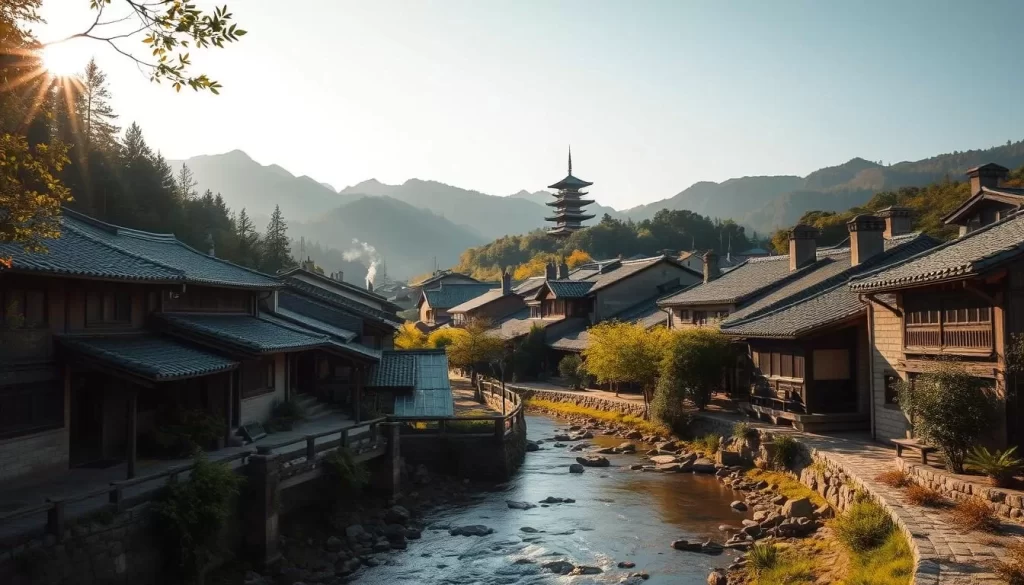
Admire the Architecture and Local Craft Shops
The traditional Korean houses here are a sight to behold. Each hanok is carefully designed with intricate wooden beams and tiled roofs, showcasing the artistry of the past. As you walk through the village, you’ll notice how these homes blend seamlessly with the modern world.
Local craft shops add to the charm of the area. From handmade pottery to traditional textiles, these stores offer unique souvenirs that reflect the village’s heritage. Don’t forget to stop by the small eateries for a taste of authentic flavors.
- Explore the narrow streets lined with hanok houses.
- Visit craft shops for one-of-a-kind treasures.
- Consider renting a hanbok to fully immerse yourself in the experience.
Every corner of this area tells a story, making it a must-visit for anyone seeking a deeper connection to traditional Korean culture. Whether you’re admiring the architecture or browsing the shops, you’ll leave with a newfound appreciation for this timeless village.
Stroll Across Woljeonggyo Bridge at Sunset
As the sun dips below the horizon, the Woljeonggyo Bridge transforms into a breathtaking canvas of light and color. This iconic spot is a favorite among photographers and travelers alike, offering a perfect blend of history and natural beauty.
The bridge, spanning 266 meters, is the largest wooden structure of its kind in the region. Its dramatic lighting at sunset creates a magical atmosphere, making it a must-visit for anyone exploring the area. The golden hour is the best time to capture its beauty, as the bridge transitions from red to golden hues.
Tips for Capturing Stunning Sunlit Photos
To make the most of your visit, plan your time carefully. Sunset hours typically fall between 6 PM and 8 PM, depending on the season. Arriving early ensures you avoid crowds and secure the best angles for your photos.
Use a tripod to stabilize your camera and experiment with different settings. A lower aperture (f/8 or lower) can enhance the depth of field, while a slower shutter speed captures the soft, warm light of the setting sun. For a unique perspective, try shooting from the sides of the bridge to include its reflection in the water.
At night, the bridge’s modern lighting system highlights its historical architecture, creating a striking contrast. This combination of old and new makes it a standout spot for both daytime and evening photography.
| Feature | Details |
|---|---|
| Bridge Length | 266 meters |
| Best Time to Visit | 6 PM – 8 PM (sunset hours) |
| Lighting Display | Red to golden hues at sunset |
| Photography Tips | Use a tripod, lower aperture, and experiment with angles |
Whether you’re a professional photographer or a casual traveler, Woljeonggyo Bridge offers an unforgettable experience. Its blend of history, natural beauty, and modern lighting makes it a highlight of any trip.
Experience Donggung Palace and Wolji Pond at Night
As night falls, the historic Donggung Palace and Wolji Pond come alive with a magical glow. This iconic site, once a royal banquet venue, transforms into a breathtaking spectacle under the stars. The interplay of modern lighting and ancient architecture creates a romantic atmosphere that’s perfect for an evening stroll.
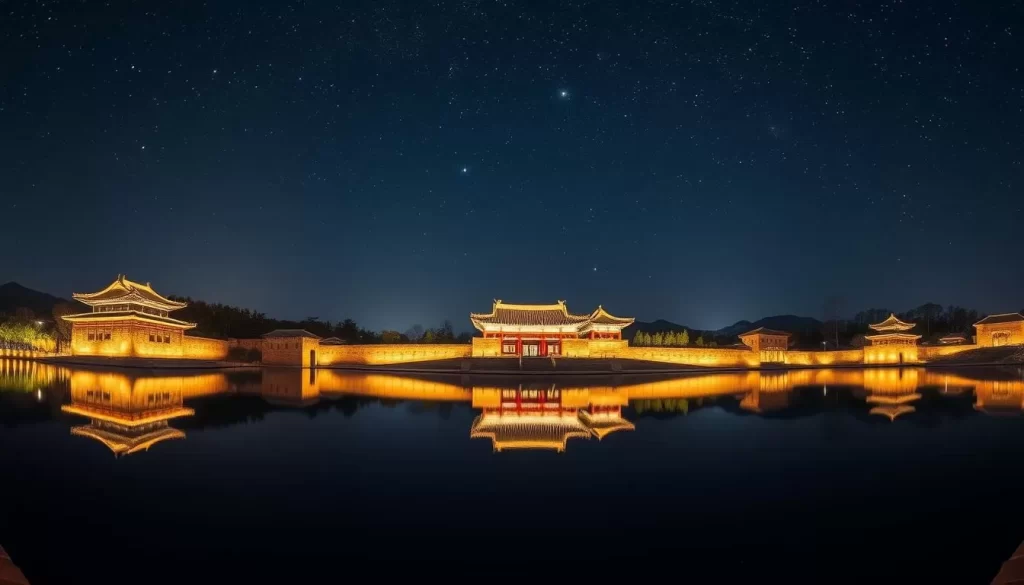
Enjoy the Magical Nighttime Lighting
The palace wolji pond is renowned for its enchanting lighting display. As darkness descends, the pond reflects the illuminated structures, creating a dreamlike scene. The donggung palace wolji area is particularly stunning, with lights highlighting intricate stonework and traditional designs.
Visitors often describe the experience as stepping into a fairytale. The combination of soft lighting and serene surroundings makes it a favorite spot for photographers and couples alike. Don’t forget to bring your camera to capture this unforgettable moment.
Understanding the History of the Royal Banquet Site
Built in 674, Donggung Palace served as a venue for royal feasts and celebrations during the Silla Dynasty. Its strategic location by Wolji Pond provided a picturesque backdrop for grand events. Today, the site offers a glimpse into the opulence of the past, with its well-preserved structures and historical significance.
Exploring the palace wolji area after dusk allows you to appreciate its detailed architecture. From the stone pathways to the traditional pavilions, every element tells a story of a bygone era. Take your time to soak in the history and beauty of this remarkable site.
- Visit during sunset to witness the transition from day to night.
- Wear comfortable shoes for walking around the pond and palace grounds.
- Check the weather beforehand to ensure clear skies for the best views.
Whether you’re a history enthusiast or simply seeking a romantic evening, Donggung Palace and Wolji Pond offer an experience like no other. Plan your visit to see this magical transformation for yourself.
Gyeongju, South Korea: Best Things to Do – Top Picks
This city offers a mix of cultural treasures and modern experiences that make it a must-visit place. From ancient tombs to serene ponds, every spot tells a story of its rich heritage. Here’s a recap of the top things to do to make your trip unforgettable.
Start your journey at the Daereungwon Tomb Complex, where 23 ancient tombs offer a glimpse into the past. Don’t miss the Cheonmachong Tomb, which houses fascinating artifacts. Next, visit the Cheomseongdae Observatory, the oldest astronomical observatory in Asia, and marvel at its unique design.
For a traditional experience, wander through Gyochon Hanok Village. Admire the hanok houses and explore local craft shops for unique souvenirs. As the day ends, head to Woljeonggyo Bridge for a stunning sunset view. The bridge’s lighting creates a magical atmosphere perfect for photography.
At night, visit Donggung Palace and Wolji Pond. The illuminated structures reflect on the water, offering a romantic and serene experience. Each of these spots adds a unique touch to your trip, ensuring a memorable adventure.
Practical Tips for Your Visit
To make the most of your time, plan your itinerary carefully. Here’s a quick guide to help you navigate the city efficiently:
| Spot | Best Time to Visit | Admission Fee |
|---|---|---|
| Daereungwon Tomb Complex | Morning | Adults W3,000; Children W1,000 |
| Cheomseongdae Observatory | Afternoon | Adults W4,000; Children W2,000 |
| Wolji Pond | Evening | Adults W2,000; Children W600 |
Whether you’re exploring ancient tombs or capturing the beauty of a sunset, this place promises an unforgettable trip. Every thing you do here adds to the richness of your experience, making it a city worth revisiting.
Visit Bulguksa Temple and Seokguram Grotto
Discover the serene beauty of two UNESCO World Heritage Sites. Bulguksa Temple and Seokguram Grotto are must-visit destinations that offer a glimpse into the spiritual and cultural legacy of the Silla Dynasty. These sites attract millions of visitors annually, making them key highlights of any trip.
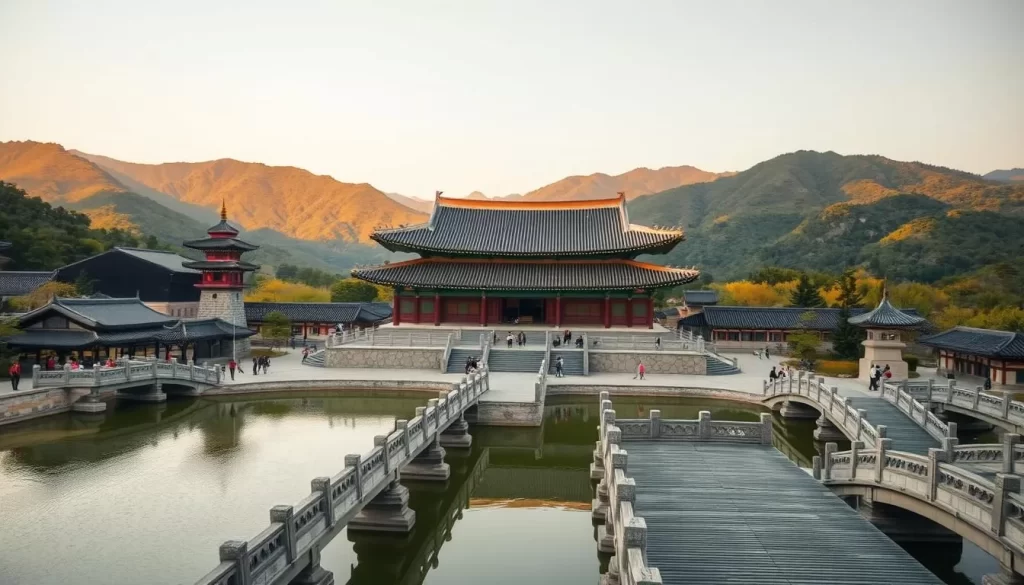
How to Easily Reach These UNESCO Sites
Getting to these iconic locations is straightforward. From the city center, you can take a bus or taxi to Bulguksa Temple, which is about an hour away. For Seokguram Grotto, a short shuttle ride from the temple will take you to this breathtaking site.
Public transportation is reliable, but renting a car can offer more flexibility. Plan your journey early to avoid crowds, especially during peak seasons. For a detailed itinerary, check out this Gyeongju day trip guide.
What to Expect During Your Visit
When you arrive at Bulguksa Temple, you’ll be greeted by intricate wooden structures and stone pagodas. The temple, built in the 8th century, is a masterpiece of Buddhist architecture. Take your time to explore the serene courtyards and admire the detailed carvings.
Seokguram Grotto offers a tranquil retreat with its stone Buddha statue. The grotto’s design reflects the harmony between nature and spirituality. Visitors often describe the experience as deeply moving and reflective.
“The peace and beauty of these sites are unmatched. It’s like stepping into a different world.”
Here’s a quick guide to help you plan your visit:
| Site | Admission Fee | Best Time to Visit |
|---|---|---|
| Bulguksa Temple | W5,000 (Adults) | Morning |
| Seokguram Grotto | W8,000 (Adults) | Late Afternoon |
Whether you’re a history enthusiast or seeking a peaceful escape, these sites promise an unforgettable experience. Plan your visit to fully immerse yourself in their timeless beauty.
Discover the Vibrant Secrets of Hwangnidan-Gil
Step into a lively urban escape where modern charm meets creativity. Hwangnidan-Gil is a bustling street that offers a refreshing contrast to the city’s historical sites. Here, trendy cafés, boutique shops, and artistic vibes create a dynamic atmosphere that’s perfect for modern explorers.
Explore Trendy Cafés and Boutique Shops
This street is a haven for coffee lovers and fashion enthusiasts. Popular cafés like Hwangnidan Coffee and Street 101 serve up unique blends and Instagram-worthy desserts. Each spot has its own personality, making it a delight to explore.
Boutique shops line the street, offering everything from handmade jewelry to stylish clothing. These stores are perfect for finding one-of-a-kind souvenirs. Whether you’re sipping a latte or browsing for treasures, the energy here is infectious.
Must-Try Treats and Beverages
Don’t miss the chance to try local favorites like honey butter bread or matcha lattes. Many cafés also feature seasonal specials, so there’s always something new to discover. Pair your treat with a freshly brewed coffee for the ultimate experience.
Here’s a quick guide to some must-visit spots:
| Spot | Specialty |
|---|---|
| Hwangnidan Coffee | Artisan coffee and desserts |
| Street 101 | Seasonal drinks and pastries |
| Boutique Lane | Handmade crafts and fashion |
The lively atmosphere of Hwangnidan-Gil makes it a favorite among young travelers and culture seekers. Take your time to wander, explore, and soak in the creativity that defines this vibrant street. For more insights on planning your visit, check out this Gyeongju travel guide.
Savor Authentic Gyeongju Flavors: Hwangnam Bread & More
Indulge in the rich flavors of a city where every bite tells a story. From sweet pastries to hearty traditional meals, the local food scene is a feast for the senses. A visit here isn’t complete without exploring the culinary treasures that have been cherished for generations.
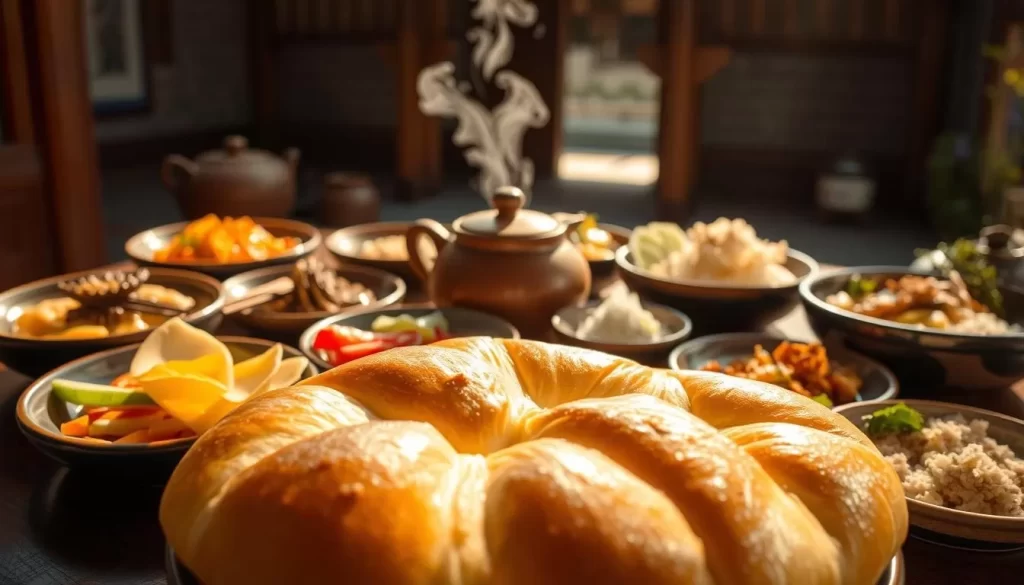
Local Pastries and Traditional Korean Food
One of the must-try delicacies is Hwangnam Bread, a soft pastry filled with sweet red bean paste. This iconic treat has been a local favorite for decades, offering a perfect balance of texture and flavor. Pair it with a cup of traditional tea for an authentic experience.
Beyond pastries, the city’s restaurants serve a variety of traditional Korean dishes. From savory bibimbap to spicy kimchi stew, each meal reflects the region’s rich culinary heritage. Many eateries also offer vegetarian and Halal-friendly options, catering to diverse tastes.
Where to Find the Best Eats
For a memorable day of culinary exploration, head to popular spots like Hwangnam Bread Street or Myeongdong Food Street. These areas are bustling with vendors and restaurants offering everything from street snacks to full-course meals.
Don’t forget to capture your food adventures with photos. The vibrant colors and textures of the dishes make for stunning visuals. Whether it’s a steaming bowl of noodles or a plate of golden pastries, every dish tells a story worth remembering.
“The flavors here are unlike anything I’ve tasted before. It’s a journey through history with every bite.”
Here’s a quick guide to some must-visit spots:
| Spot | Specialty |
|---|---|
| Hwangnam Bread Street | Hwangnam Bread and traditional pastries |
| Myeongdong Food Street | Street snacks and Halal-friendly options |
| Local Restaurants | Bibimbap, kimchi stew, and more |
For more insights on planning your culinary journey, check out this Gyeongju’s vibrant food scene. Whether you’re a foodie or just looking to try something new, the city’s flavors promise an unforgettable experience.
Plan Your Itinerary: Day Trips and Hidden Gems
Crafting the perfect itinerary ensures you make the most of your time in this historic city. Whether you’re here for a short visit or an extended stay, these suggestions will help you balance history, culture, and modern experiences.
Suggested Itineraries for 2 or 3-Day Trips
For a 2-day trip, start with the Daereungwon Tomb Complex in the morning, followed by a visit to Cheomseongdae Observatory in the afternoon. End your day with a stroll across Woljeonggyo Bridge at sunset.
On your second day, explore Bulguksa Temple and Seokguram Grotto in the morning. Spend the afternoon at Hwangnidan-Gil, enjoying trendy cafés and boutique shops.
If you have a third day, consider visiting Donggung Palace and Wolji Pond at night for a magical experience. Add a trip to Gyochon Hanok Village for a traditional touch.
Best Times to Visit Major Attractions
To avoid crowds, visit popular sites like Bulguksa Temple early in the morning. The Cheomseongdae Observatory is less crowded in the late afternoon, offering a peaceful experience.
For a quieter evening, head to Wolji Pond after sunset. The nighttime lighting creates a serene atmosphere, perfect for reflection.
Hidden Gems and Off-the-Beaten-Path Attractions
Discover lesser-known spots like Bomun Lake Resort, which offers scenic walking trails and recreational activities. It’s a great place to unwind after a busy day of sightseeing.
Another hidden gem is the Gyeongju World Culture Expo Park. This modern attraction features museums, gardens, and a sculpture park, providing a full day of exploration.
Practical Planning Tips
Plan your days to include a mix of historical and modern attractions. This balance ensures a well-rounded experience. Use public transportation or rent a car for flexibility.
For a stress-free trip, book accommodations near major attractions. This saves time and allows for more spontaneous exploration. Check out this 10-day South Korea itinerary for more inspiration.
With these tips and itineraries, you’re ready to explore this charming city. Whether you’re here for a day or a week, every moment will be filled with discovery and wonder.
Navigating Gyeongju: Transportation and Practical Tips
Getting around this historic destination is easier than you might think, with a mix of efficient transportation options. Whether you prefer walking, taking the bus, or hopping in a taxi, the city is designed to make your journey smooth and enjoyable.
How to Get Around by Bus and On Foot
The bus network here is reliable and covers most major attractions. A single ride takes about an hour to reach places like the Daereungwon Tomb Complex or Bulguksa Temple. For shorter trips, taxis are a convenient option, especially if you’re traveling with a group.
Walking is one of the best ways to explore the city. Many attractions, like the Cheomseongdae Observatory and Gyochon Hanok village, are within a short distance of each other. Strolling through these areas lets you soak in the atmosphere and discover hidden gems along the way.
Practical Tips for Exploring Local Neighborhoods
To make your trip even smoother, consider getting a local transit card. It’s accepted on buses and can save you time and hassle. If you’re visiting a traditional village, wear comfortable shoes and allow at least an hour to fully explore the area.
Here’s a quick guide to travel times between key spots:
| Route | Estimated Time |
|---|---|
| City Center to Daereungwon Tomb Complex | 30 minutes |
| Bulguksa Temple to Gyochon Hanok Village | 1 hour |
| Cheomseongdae Observatory to Woljeonggyo Bridge | 20 minutes |
“Walking through the streets felt like stepping back in time. The mix of history and modern convenience made it easy to explore.”
For more tips on planning your trip, check out this South Korea travel guide. Whether you’re on foot or using public transport, every journey here is an adventure waiting to unfold.
Immerse Yourself in Gyeongju’s Cultural Legacy
Dive into a world where history comes alive through museums and heritage sites. These venues offer a deep connection to the past, showcasing the rich cultural tapestry of the region. From ancient artifacts to stunning statues, every exhibit tells a story of a bygone era.
Exploring Museums and Heritage Sites
The Gyeongju National Museum is a must-visit, housing the best collection of Silla dynasty treasures. Here, you’ll find over 12,000 artifacts, including intricate statues and stone relics that date back centuries. Each piece offers a glimpse into the lives and beliefs of ancient civilizations.
Another highlight is the Daereungwon Tomb Complex, where over two dozen royal tombs are located. These tombs, believed to belong to kings and high-ranking officials, are a testament to the grandeur of the Silla dynasty. Walking through this complex feels like stepping back in time.
Heritage sites like the Bulguksa Temple and Seokguram Grotto are equally captivating. Built in the 6th century, these UNESCO World Heritage sites showcase the region’s architectural brilliance and spiritual depth. The stone carvings and statues here are particularly noteworthy.
“The museums and heritage sites here are more than just attractions—they’re gateways to understanding a rich and vibrant history.”
For a deeper dive into South Korea’s vibrant history and heritage, these sites are essential. They provide not only educational value but also a profound sense of connection to the past.
Plan your visit to include these cultural landmarks. Allocate sufficient time to explore each site thoroughly, as they offer a unique journey through time and culture. Whether you’re a history enthusiast or a casual traveler, these experiences will leave a lasting impression.
Conclusion
Every year, travelers are drawn to a place where history and modernity coexist in perfect harmony. This city offers a unique blend of ancient heritage and vibrant contemporary life, making it a must-visit destination. Whether you explore its royal tombs, serene temples, or bustling streets, each part of your journey will leave a lasting impression.
Each season brings its own charm, from cherry blossoms in spring to the golden hues of autumn. By night, the illuminated landmarks create a magical atmosphere, while daytime adventures reveal the depth of its cultural legacy. Every thing you experience here adds to the richness of your visit.
Plan your trip to include both day and night explorations. Spend an hour wandering through ancient sites or enjoy the lively energy of modern neighborhoods. For more tips on making the most of your visit, check out this guide to exploring on a budget.
This remarkable city invites you to immerse yourself in its layered history and vibrant present. Make it a central part of your travel adventures and create memories that will last a lifetime.
The above is subject to change.
Check back often to TRAVEL.COM for the latest travel tips and deals.
